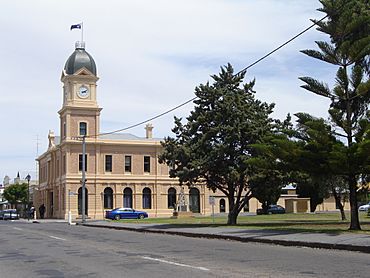Moonta, South Australia facts for kids
Quick facts for kids MoontaSouth Australia |
|||||||||||||||
|---|---|---|---|---|---|---|---|---|---|---|---|---|---|---|---|

Moonta Town Hall
|
|||||||||||||||
| Established | 1863 | ||||||||||||||
| Postcode(s) | 5558 | ||||||||||||||
| Elevation | 44 m (144 ft) | ||||||||||||||
| Location | |||||||||||||||
| LGA(s) | Copper Coast | ||||||||||||||
| State electorate(s) | Narungga | ||||||||||||||
| Federal Division(s) | Grey | ||||||||||||||
|
|||||||||||||||
|
|||||||||||||||
| Footnotes | Climate | ||||||||||||||
Moonta is a cool town in South Australia, located about 165 kilometers (102 miles) northwest of Adelaide. It's one of three towns known as the Copper Coast or "Little Cornwall". This is because Moonta, along with two other towns, has a rich history of copper mining.
Contents
Discover Moonta: A Town with History
Moonta is about 17 kilometers (11 miles) southwest of Kadina and 14 kilometers (9 miles) south of Wallaroo. Many smaller areas, like Moonta Bay and Port Hughes, surround the main town.
Moonta has been growing quickly! In 2011, about 3,659 people lived in the wider Moonta area. By 2021, this number had jumped to 5,219, making it the fastest-growing place on the Copper Coast.
Moonta's Past: From Ancient Lands to Mining Boom
The First People of Moonta
The land around Moonta has always been important to the Narungga people, who are the traditional owners of this area. The name "Moonta" might come from an Aboriginal word, munta-muntara or moontera. This word means "thick scrub place" or "impenetrable scrub," describing the dense bushes that once covered the area.
European Settlers and Copper Discovery
European explorers like Matthew Flinders and Nicolas Baudin sailed along the Yorke Peninsula coast in 1802. Later, in 1840, John Hill and Thomas Burr explored the land near Moonta Bay. They reported finding "a very excellent tract of country."
However, not many European settlers came at first because there wasn't much water. The thick scrub also made it hard to clear the land for farming.
Everything changed in 1861 when Patrick Ryan, a shepherd, discovered huge amounts of copper at Moonta. This discovery led to the opening of a very successful mine called Wheal Hughes. Soon, more mines popped up. The town of Moonta was officially planned in 1863.
Many Cornish miners came to Moonta from England to work in the mines. By 1875, Moonta was a bustling town with 12,000 people! The Moonta mines became the richest in all of South Australia by 1917.
Most copper mining stopped in 1923. After the mines closed, the area became known for farming. Today, farmers grow crops like barley and wheat around Moonta. Barley from this region is considered some of the best in the world!
Moonta's Railway Journey
A special horse-drawn tramway was built in 1866 to carry copper from the Moonta mines to the port at Wallaroo. Later, this tramway was upgraded to a railway for steam trains in 1891.
Passenger trains stopped running in 1969, and the railway line closed in 1984. Today, the old Moonta railway station is a museum run by the National Trust. It's also the starting point for the Moonta Mines Tourist Railway, which takes visitors on a fun ride through the historic mining area.
Historic Places to See in Moonta
Moonta's town center feels very historic, with old limestone miners' cottages and churches. Many places in Moonta are listed on the South Australian Heritage Register, meaning they are important historical sites. Some of these include:
- All Saints Anglican Church
- Moonta Masonic Hall
- The old Bank of South Australia Building
- The Moonta School of Mines
- The Moonta railway station
Weather and Environment in Moonta
Moonta has a dry Mediterranean climate, similar to Adelaide and Kadina. It's located in a semi-arid area, which means it doesn't get a lot of rain. The town is surrounded by mallee scrub, a type of bushland.
Moonta's Economy: Tourism and Heritage
Today, tourism is a big part of Moonta's economy. People love to visit for beach holidays, staying in caravan parks, holiday houses, or motels. Nearby places like Moonta Bay and Port Hughes are very popular for holidays and retirement. The beautiful beaches with white sand are great for fishing and sailboarding.
Every two years in May, Moonta, Kadina, and Wallaroo host the exciting three-day Kernewek Lowender Cornish festival. This festival celebrates the area's Cornish heritage with lots of fun events. In 2021, Moonta was even named South Australia's first "Top Tourist Town"!
The National Trust of South Australia helps preserve Moonta's mining history. They run several attractions at Moonta Mines, including:
- A special narrow-gauge railway that takes you through the old mining areas.
- A museum located in the former Moonta Mines Model School.
- A sweet shop and a preserved mining cottage.
- The old Moonta railway station, which is now a visitor information center.
Moonta in the News
Moonta has had several local newspapers over the years. The People’s Weekly served the town from 1890 to 1961. After a few name changes and mergers with other local papers, it eventually became the Yorke Peninsula Country Times in 1968. This newspaper still serves the entire Yorke Peninsula today.
Images for kids
-
Aerial view of Moonta, looking west into Spencer Gulf














